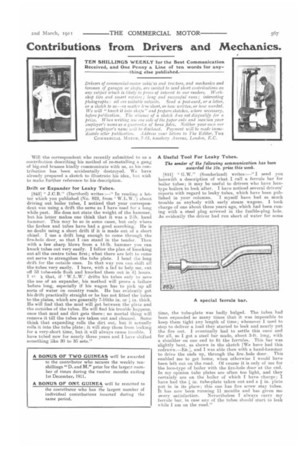Contributions from Drivers and Mechanics.
Page 25

If you've noticed an error in this article please click here to report it so we can fix it.
TEN SHILLINGS WEEKLY for the Best Communication Received, and One Penny a Line of ten words for any-.
thing else published.
Drivers of commercial-motor vehic'es and tra:lors, and mechanics and foremen of garages or shops, are invited to send short contributions on any subject which is likely to prove of interest to our readers. Workshop lips and smart repairs ; long and successful runs; interesting photographs: all are suitable subjects. Send a post-card, or a letter, or a sketch to us—no matter fine short, or how written, or how worded. We will " knock it into shape" ow/ prepare sketches, where necessary, before publicaticm, The absence of a sketch dies not disqualify for a prize. When writing use one side of the paper only and mention your employer's name as a guaranta of bona fides. Neither your own nor your employer's it a me will be disclosed. Payment will be made immediately after Publication. Address your letters to The Editor, MR COMMZRCIAL MOTOR, 7-15. kosebery Avenue, London, E.G.
Will the correspondent who recently submitted to us a contribution describing his method of re-metalling a gang of big-end brasses kindly communicate with us, as his contribution has been accidentally destroyed. We have already prepared a sketch to illustrate his idea, but wish to make further reference to his description.
Drift or Expander for Leaky Tubes.
[843] " J.C.B." (Dartford) writes In reading a let
ter which you published (No. 823, from W.L.W.') about driving out boiler tubes, I noticed that your correspondent was using a drift the same as I have used for a long while past. He does not state the weight of the hammer, but his letter makes one think that it was a 2-1b. hand hammer. This may be so in some cases, but only where the firebox and tubes have had a good scorching. He is no doubt using a short drift if it is made out of a short chisel. I use a drift long enough to come through the fire-hole door, so that I can stand in the tender. Then with a few sharp blows from a 14-1b. hammer you can knock tubes out very easily. I follow the plan of knocking out all the centre tubes first ; what there are left to come out serve to strengthen the tube plate. I bend the long drift for the outside ones. In that way you can shift all the tubes very easily. I have, with a lad to help me, cut olf 53 tube-ends flush and knocked them out in it hours. I th k that, if W.L.W.' drifts his tubes only to save the use of an expander, his method will prove a failure before long, especially if his wagon hiss to pick up all sorts of water on country roads. He has evidently got his drift practically straight or he has not fitted the tubes to the plates, which are generally 7-18ths in. or in. thick. He will find that the mud will get between the plate and the olitsides of the tubes. He will find his trouble happens, once that mud and dirt gets there; no mortal thing will remove it till the tubes are taken out and cleaned. Some think that expanding rolls the dirt out, but it actually rolls it into the tube plate; it will stop them from leaking for a very-short time, but it will always cause truuble. I have tubed now for nearly three years and I have shifted something like 30 to 95 sets." A Useful Tool For Leaky Tubes.
The render of the following communication has been awarded the 10s. prize this week.
[844] " G.W." (Sunderland) writes ;—" I send you herewith a description of what I call a ferrule bar for boiler tubes; it may be useful to drivers who have locotype boilers to look after. I have noticed several drivers' reports with regard to leaky tubes, which have been pub lished in your columns. I myself have had as much trouble as anybody with early steam wagons. I took charge of one about three years ago, which had been runing with a steel plug screwed in the fusible-plug hole. As evidently the driver had run short of water for ROME
A special ferrule bar.
time, the tube-plate was badly bulged. The tubes had been expanded so many times that it was impossible to keep them tight any length of time; whenever I used to stop to deliver a load they started to leak and nearly put the fire out. I eventually had to settle this once and for all, so I got a steel bar made, about 3-ft. long, with a shoulder on one end to fit the ferrules. This bar was slightly bent, as shown in the sketch [We have had this. redrawn.—Ere], and I was able then with a hand-hammer to drive the ends up, through the fire-hole door. This enabled me to get home, when otherwise I would have been left out on the road. Of course it is only of use for the loco-type of boiler with the fire-hole door at the end. In my opinion tube plates are often too light, and they certainly are on the boiler of which I have charge; I have had the in. tuheplate taken out and a f in. plate put in in its place; this one has five screw stay tubes. It has now been running 11 mouths and has given me every satisfaction. Nevertheless I always carry my ferrule bar, in case any of the tubes should start to leak while I am on the road."


























